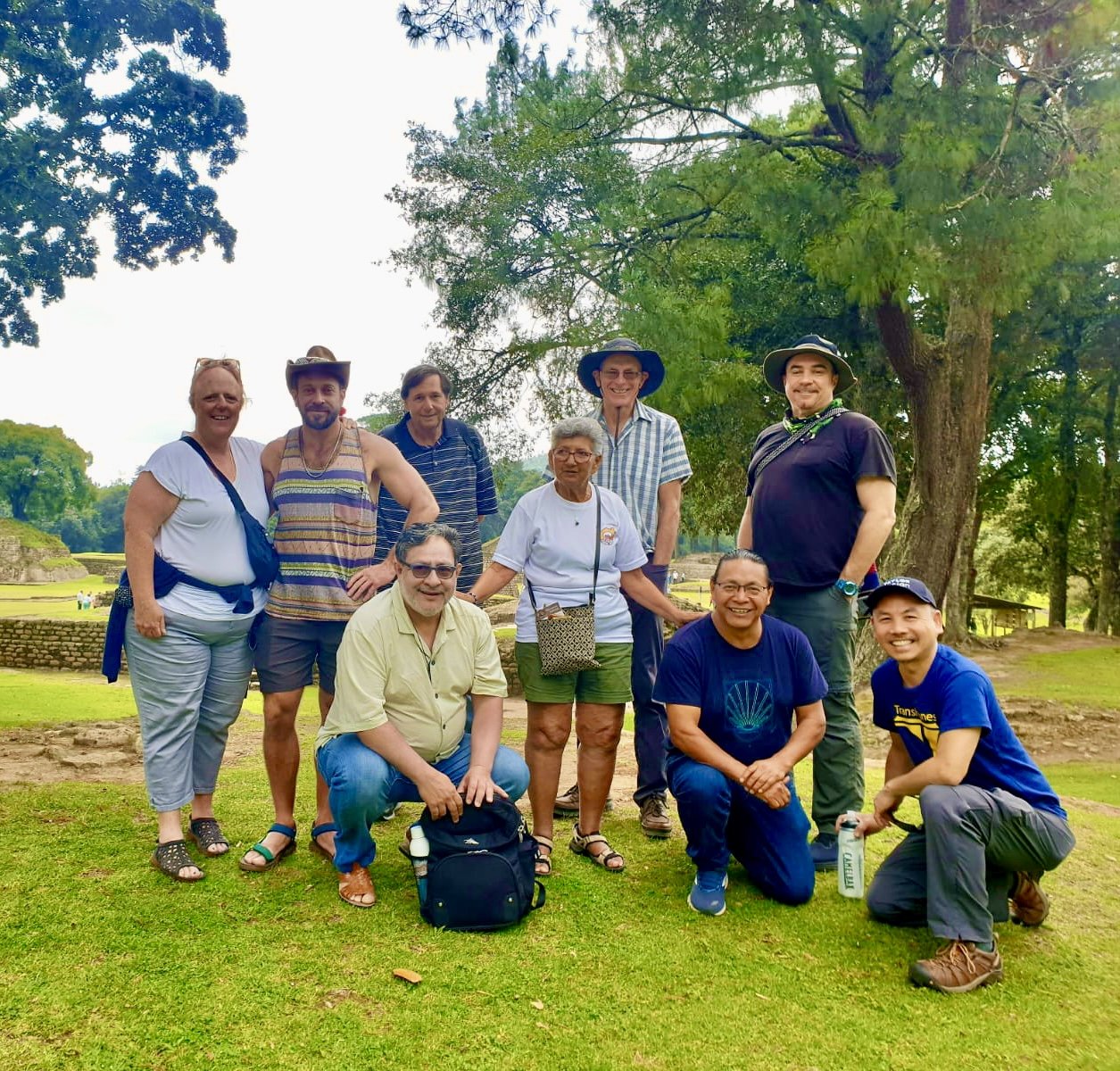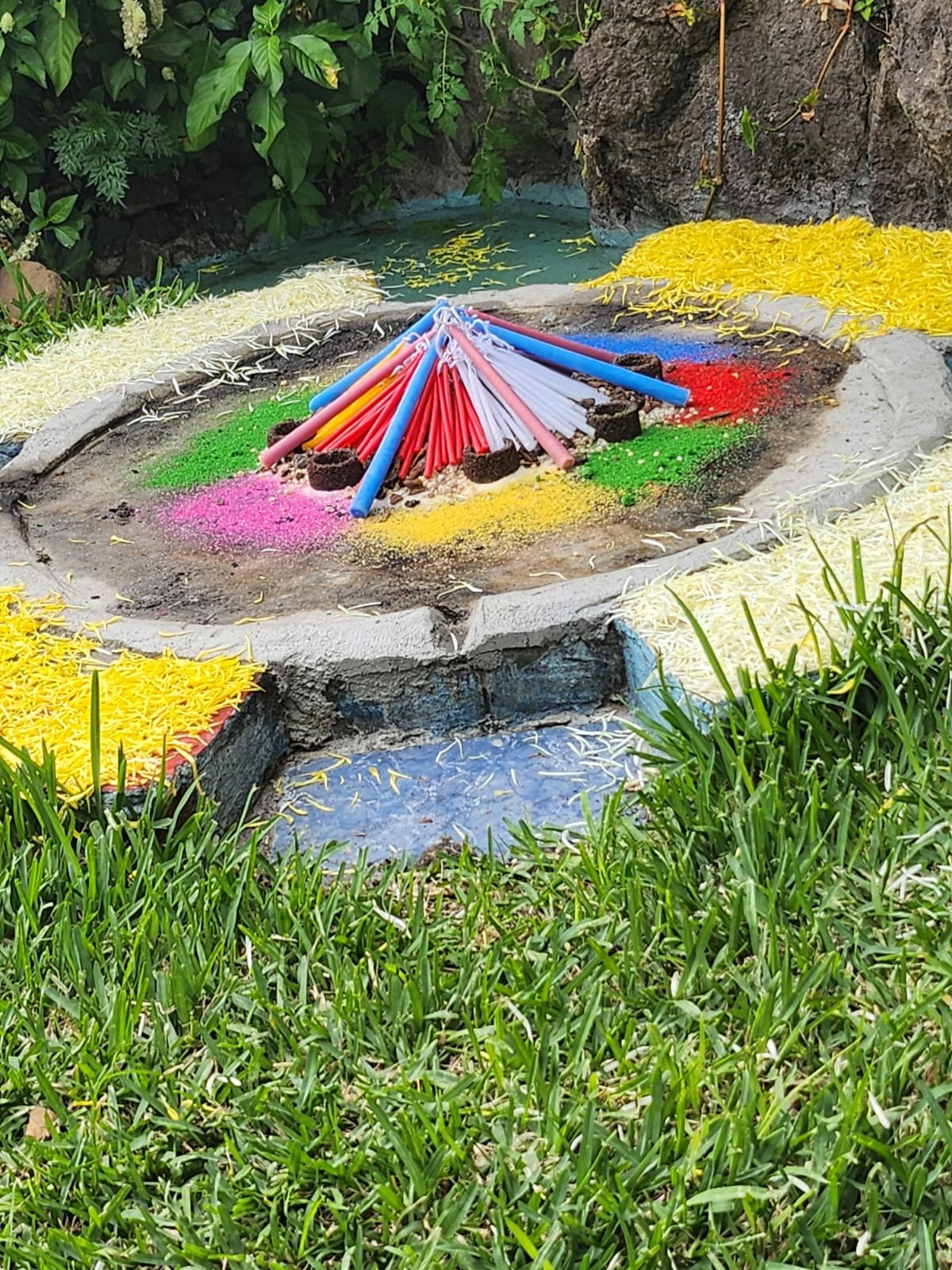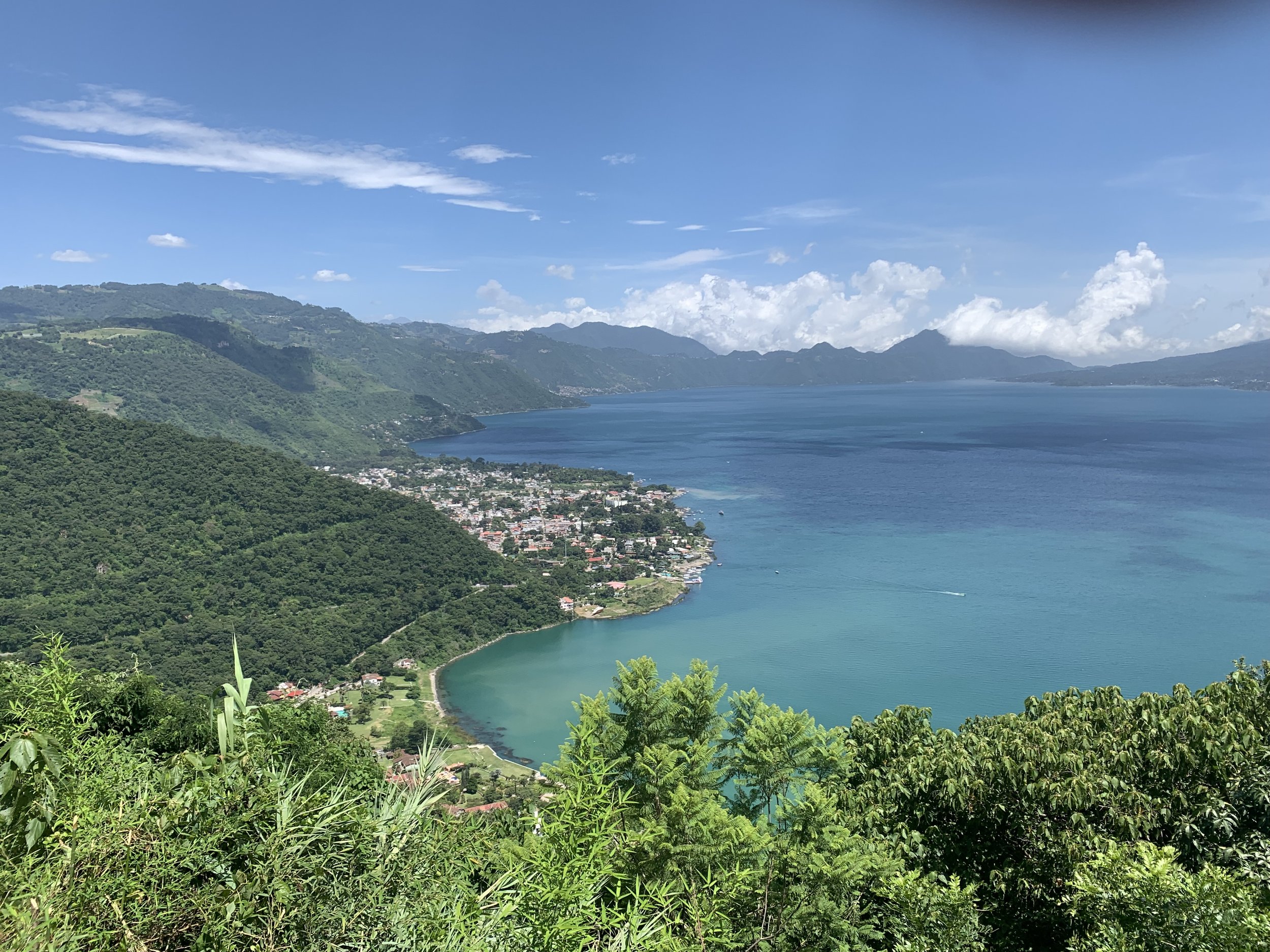Arco de Santa Catalina, Antigua Guatemala
MY Guatemala Journal -2023
My name is Bill Prince, I went with Rainbow World Fund (RWF) to Cuba in 2015, and really loved it, but as soon as I heard that Rainbow also traveled to Guatemala, I was eager to sign up, though I had to wait three years due to delays by Covid. I knew little about the country, but somehow had the intuition that it would be a land of great natural beauty, of colonial history and ancient Mayan traditions, of marvels and miracles. It was all these things, and much much more.
On the road less traveled with Bill Prince.
Seven of us, with guides Doris and Julio from World Pilgrim, stayed in three cities. First, Antigua, ancient colonial capital destroyed in an earthquake 250 years ago, with some buildings still in ruins and Volcano Fuego belching ash not so far away. Then Panajachel, on immense Lake Atitlán, the lake surrounded by traditional Mayan villages, some reachable only by boat, and home of impressive Mayan weavers, painters, and other artisans. Finally Quetzaltenango (Xela)…well, more about Xela later.
Visiting a Mayan archaeological site with all of my trip mates: Doris Kizinna, Philippe Gosselin, Neil Young, Dimas Moncada, Nacyra Gomez, Bill Prince, Julio Alva, Jeff Cotter, and Yew-Hoe Tan.
We sampled the pleasures of Guatemala. The country’s 37 volcanoes feed hot springs, including pools on the grounds of one of our hotels, and a complex far in the mountains, deep in the rain forest. In a nature reserve near Panajachel, spider monkeys swung from their tails only 30 yards from us, and we crossed the chasm in front of a waterfall on rickety swinging bridges. We ate Guatemalan cuisine, including a wide variety of fresh fruit, the traditional mole-like chicken stew called pepiàn, and a scrumptious chicken soup loaded with rice and vegetables.
Volcano Fuego rising imperiously above the central highland city of Antigua.
Fine hand-crafted textiles were everywhere. You could tell what village many people are from by the traditional clothing they wear. At a women’s weaving cooperative we saw the whole process from spinning the cotton, to making the dyes from flowers, barks, and even insects, to weaving the final product on a hand-made loom. Textiles, and practically everything else including meat, vegetables, and live animals, are sold in the immense, fantastic twice-weekly market in Chichicastenango. We visited a painters’ collective in San Juan La Laguna spanning the range from traditional styles to marvelous brightly colored almost cubist scenes.
Transitions advocates for the rights and social inclusion of Guatemalans with disabilities by providing access to social programs, mobility equipment, and opportunities for independent living that promote human dignity.
Ours was not primarily a tourist visit, however. Rainbow World Fund sponsors schools, elder centers, LGBTQ+ organizations, and other grass-roots groups that combat Guatemala’s poverty, discrimination, and neglect of education and medical care.
I was utterly charmed by these children when we visited them at school.
Transitions, near Antigua, hires employees with lower-extremity paralysis or disability to repair and fabricate wheelchairs, carefully fitting the size and type to the individual’s needs. Their athletic-style wheelchairs, light, maneuverable, and stable, were in use in a vigorous and competitive practice game of wheelchair basketball on the grounds, featuring many members of the Guatemalan National Wheelchair Basketball Team.
We delivered medical and education supplies to this preschool.
In San Jorge La Laguna, absolutely-adorable four-year-olds in a pre-school run by Funda Maya performed traditional dances in traditional dress. Two group members agreed to sponsor one of the children, to provide school supplies, food for the children’s lunches, and support for the child’s family. We served lunch to two room-fulls of elders, many living alone and without income. In the village we delivered a bed to a family of five who lived in a mud-brick home with a dirt floor and no window, electricity, or running water.
I fell in love with the chicken soup.
Altar at the church at San Jorge La Laguna.
Near Xela was a great treat for all concerned — our visit to the elementary school in the Mayan town Chwitziribal. World Pilgrim began supporting the village’s elementary school years ago, funding the construction of a new school building, and visiting many times since. The children literally screamed as we arrived, performed dances and songs, ate lunch we’d brought (fried chicken from Pollo Campero), and took home a T-shirt, toothbrush and toothpaste, and a colored pencil set. Before World Pilgrim’s support, few students from the village finished high school, and none went to college. Before we left the area, we visited one of the five graduates now attending college, who studies accounting on the weekends and earns money during the week by weaving gorgeous textiles in a very rustic workshop behind her family’s simple country home.
Making a new friend named Omar.
Our visit to the elementary school in the Mayan town Chwitziribal.
Guatemala’s economics, and history, are troubled. Many thousands of Guatemalans have emigrated to the US to find work. To make it personal, our driver Marco told the harrowing story of his perilous trip to the US. Though Guatemala’s civil war ended 27 years ago, the assassination of probably 250,000 citizens, mostly Mayan, by the military government during those 27 years is a trauma that is part of everyday life for many. Our guide Julio told of the occupation of his village, Santa Lucia Utitlán, by a military death and torture squad when he was 16, and of the murder of his uncle, cousin, and friends. The women’s textile cooperative Trama Textiles in Xela was founded in part so that rural women whose husbands had been killed or disappeared could support their families.
We visited the home of this young weaver. She attends college and is studying accounting.
With a family we had the privilege of spending time with In San Jorge La Laguna.
Mayan spirituality thrives in Guatemala, despite being considered demonic by Guatemala’s traditional Catholicism and by its surging, more recent evangelical Christianity. We saw Mayan altars and ceremonies in progress in the ruins of the ancient Mayan city of Iximche, in front of the Catholic Church of Chichicastenango, and in the town’s graveyard. We were lucky enough to meet two Mayan elders. Spiritual leader Nan Maria in San Juan La Laguna led us in a traditional Mayan healing ceremony centered on our relationship with Mother Nature and our ancestors, intensely personal and deeply moving. Nan Maria in Santa Lucia, a dear friend of Doris and Julio’s, prayed for us and left us with a hug, twinkling eyes, and a smile full of love.
Fire plays a crucial role in Mayan culture, it is believed to be a powerful force that connects humans with the spiritual realm.
The main shopping street in San Juan La Laguna.
The struggle for LGBTQ-plus rights, though dangerous and unpopular, is alive and well in Guatemala. A Funda Maya staff member in Panajachel introduced us to her gay friends Antonio and Guillermo, who movingly described their own struggles for acceptance by peers and family. Their friend Enrique described his brilliant successes in drawing together the region’s LGBTQ-plus community for Pride celebrations that are becoming more and more popular every year. In Antigua at the end of our trip, we had lunch with OTRANS organizers Angela and Stacy, who continue to fight for trans rights on both the national legislative and personal levels. All told of attacks and even murders of LGBTQ-plus individuals in their communities.
At a nature preserve near Panajachel.
Visiting a cemetery in Chichicastenango.
Visiting with OTRANS leaders.
Our leaders— Jeff Cotter, founder of Rainbow World Fund, and Doris Kizinna, founder of World Pilgrim.
And all of this in only ten days! At a wrap-up meeting the last night, we spoke of how impressed we were with Guatemala’s natural beauty, with the resilience and persistence of traditional Mayan culture, crafts, and religion, and with her grass-roots movements for progress and justice in so many areas. We were moved by what we saw and by our ability to help. Our trip was indeed, in the words of one participant, a pleasure, a privilege, and a blessing.
Lake Atitlán from the south.
Guatemala is a very mountainous country.
With Nan Maria a local shaman who led us with through a Mayan ritual
Active volcanos bring lots of benefits to the soil that surrounds them
With one of my trip mates, Philippe, above Lake Atitlán.
Yew-Hoe on a school visit.
Philippe and Alexander.
Lake Atitlan from San Jorge La Laguna
A painting depicting the civil war (1960-1996).
Artists are an important critical voice in Guatemala.
Our intrepid leader getting into a tuk-tuk, a small three-wheeled taxi.
Among the textiles at the market in Chichicastenango.
The Last Supper.
































